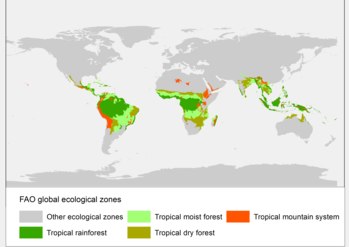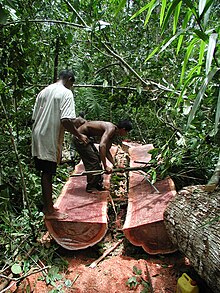Tropical forest
Tropical forests are forested landscapes in tropical regions: i.e. land areas approximately bounded by the tropic of Cancer and Capricorn, but possibly affected by other factors such as prevailing winds.

Some tropical forest types are difficult to categorise. While forests in temperate areas are readily categorised on the basis of tree canopy density, such schemes do not work well in tropical forests.[1] There is no single scheme that defines what a forest is, in tropical regions or elsewhere.[1][2] Because of these difficulties, information on the extent of tropical forests varies between sources. However, tropical forests are extensive, making up just under half the world's forests.[3] The tropical domain has the largest proportion of the world’s forests (45 percent), followed by the boreal, temperate and subtropical domains.[4]
More than 3.6m hectares of virgin tropical forest was lost in 2018.[5]
Types of tropical forest[]
Tropical forests are often thought of as evergreen rainforests[2] and moist forests, but these account for only a portion of them (depending on how they are defined - see maps). The remaining tropical forests are a diversity of many different forest types including: Eucalyptus open forest, tropical coniferous forests, savanna woodland (e.g. Sahelian forest), and mountain forests[6] (the higher elevations of which are cloud forests). Over even relatively short distances, the boundaries between these biomes may be unclear, with ecotones between the main types.



The nature of tropical forest in any given area is affected by a number of factors, most importantly:
- Geographical: location and climatic zone (see sub-types), with:
- Precipitation levels and seasonality, with strong dry seasons significantly affecting flora (e.g. the predominance of lianas);[7]
- Temperature profile, which is relatively even in equatorial rainforest or with a cooler season towards subtropical latitudes;
- Elevation affects the above, often creating "ecological islands" with high endemism (e.g. Mount Kinabalu in the Borneo rainforest).[8]
- Historical: prehistoric age of forest and level of recent disturbance (see threats), changing primary (usually maximum biodiversity) into secondary forest, degenerating into bamboo forest after prolonged swidden agriculture (e.g. in several areas of Indo-China).[9]
- Soil characteristics (also subject to various classifications): including depth and drainage.[10]
The Global 200 scheme[]
The Global 200 scheme, promoted by the World Wildlife Fund, classifies three main tropical forest habitat types (biomes), grouping together tropical and sub-tropical areas (maps below):
- Tropical and subtropical moist broadleaf forests,
- Tropical and subtropical dry broadleaf forests,
- Tropical and subtropical coniferous forests.
Extent of tropical and sub-tropical -

moist forest regions

dry forest regions

coniferous forest regions
Threats[]

A number of tropical forests have been designated High-Biodiversity Wilderness Areas, but remain subject to a wide range of disturbances, including more localized pressures such as habitat loss and degradation and anthropogenic climate change. Studies have also shown that ongoing climate change is increasing the frequency and intensity of some climate extremes (e.g. droughts, heatwaves and hurricanes) which, in combination with other local human disturbances, are driving unprecedented negative ecological consequences for tropical forests around the world.[11] All tropical forests have experienced at least some levels of disturbance.[12] Current deforestation in the biodiversity hotspots of South America, sub-Saharan Africa, South-East Asia and the Pacific, can be attributed to export of commodities such as: beef, soy, coffee, cacao, palm oil, and timber; there is a requirement for "strong transnational efforts ... by improving supply chain transparency [and] public–private engagement".[13]
A study in Borneo describes how, between 1973 and 2018, the old-growth forest had been reduced from 76% to 50% of the island, mostly due to fire and agricultural expansion.[14] A widely-held view is that placing a value on the ecosystem services these forests provide may bring about more sustainable policies. However, clear monitoring and evaluation mechanisms for environmental, social and economic outcomes are needed. For example, a study in Vietnam indicated that poor and inconsistent data combined with a lack of human resources and political interest (thus lack of financial support) are hampering efforts to improve forest land allocation and a Payments for Forest Environmental Services scheme.[15]
See also[]
Sources[]
![]() This article incorporates text from a free content work. Licensed under CC BY-SA 3.0 License statement/permission on Wikimedia Commons. Text taken from Global Forest Resources Assessment 2020 Key findings, FAO, FAO.
This article incorporates text from a free content work. Licensed under CC BY-SA 3.0 License statement/permission on Wikimedia Commons. Text taken from Global Forest Resources Assessment 2020 Key findings, FAO, FAO.
References[]
- ^ Jump up to: a b Putz, Francis E.; Redford, Kent H. (September 14, 2009). "The Importance of Defining 'Forest': Tropical Forest Degradation, Deforestation, Long-term Phase Shifts, and Further Transitions". Biotropica. Wiley. 42 (1): 10–20. doi:10.1111/j.1744-7429.2009.00567.x. ISSN 0006-3606.
- ^ Jump up to: a b Anatoly Shvidenko, Charles Victor Barber, Reidar Persson et al. 2005 "Millennium Ecosystem Assessment." Ecosystems and human wellbeing: a framework for assessment Washington, DC: Island Press
- ^ D’Annunzio, Rémi, Lindquist, Erik J., MacDicken, Kenneth G. 2017 “Global forest land-use change from 1990 to 2010:an update to a global remote sensing survey of forests Forest Resource Assessment Working Paper 187” FAO, Rome.
- ^ Global Forest Resources Assessment 2020 – Key findings. FAO. 2020. doi:10.4060/ca8753en. ISBN 978-92-5-132581-0.
- ^ Human society under urgent threat from loss of Earth's natural life. Scientists reveal 1 million species at risk of extinction in damning UN report 6 May 2019 Guardian [1]
- ^ Van Der Hammen, Thomas (1991). "Palaeoecological Background: Neotropics". Tropical Forests and Climate. Dordrecht: Springer Netherlands. pp. 37–47. doi:10.1007/978-94-017-3608-4_4. ISBN 978-90-481-4147-0.
- ^ Chen, Ya-Jun; Cao, Kun-Fang; Schnitzer, Stefan A.; Fan, Ze-Xin; Zhang, Jiao-Lin; Bongers, Frans (September 29, 2014). "Water-use advantage for lianas over trees in tropical seasonal forests". New Phytologist. Wiley. 205 (1): 128–136. doi:10.1111/nph.13036. ISSN 0028-646X. PMID 25264136.
- ^ Merckx, Vincent S. F. T.; Hendriks, Kasper P.; Beentjes, Kevin K.; Mennes, Constantijn B.; Becking, Leontine E.; Peijnenburg, Katja T. C. A.; Afendy, Aqilah; Arumugam, Nivaarani; De Boer, Hugo; Biun, Alim; Buang, Matsain M.; Chen, Ping-Ping; Chung, Arthur Y. C.; Dow, Rory; Feijen, Frida A. A.; Feijen, Hans; Soest, Cobi Feijen-van; Geml, József; Geurts, René; Gravendeel, Barbara; Hovenkamp, Peter; Imbun, Paul; Ipor, Isa; Janssens, Steven B.; Jocqué, Merlijn; Kappes, Heike; Khoo, Eyen; Koomen, Peter; Lens, Frederic; et al. (2015). "Evolution of endemism on a young tropical mountain". Nature. 524 (7565): 347–350. Bibcode:2015Natur.524..347M. doi:10.1038/nature14949. PMID 26266979. S2CID 4447746.
- ^ Heinimann, Andreas; Messerli, Peter; Schmidt-Vogt, Dietrich; Wiesmann, Urs (2007). "The Dynamics of Secondary Forest Landscapes in the Lower Mekong Basin". Mountain Research and Development. 27 (3): 232–241. doi:10.1659/mrd.0875. S2CID 102490131.
- ^ Schulte, A, Ruhiyat D (Eds.) (1998) Soils of Tropical Forest Ecosystems: Characteristics, Ecology and Management. Springer, 204 pp.
- ^ França, FM; Benkwitt, CE; Peralta, G; Robinson, JPW; Graham, NAJ; Tylianakis, JM; Berenguer, E; Lees, AC; Ferreira, J; Louzada, J; Barlow, J (2020). "Climatic and local stressor interactions threaten tropical forests and coral reefs". Philosophical Transactions of the Royal Society B. 375 (1794): 20190116. doi:10.1098/rstb.2019.0116. PMC 7017775. PMID 31983328.
- ^ Robin L. Chazdon 2003 “Tropical forest recovery: legacies of human impact and natural disturbances” Perspectives in Plant Ecology, Evolution and Systematics 6/1,2, pp. 51–71
- ^ Hoang NT, Kanemoto K (2021) Mapping the deforestation footprint of nations reveals growing threat to tropical forests. Nat Ecol Evol.
- ^ Gaveau DLA (2016) What a difference 4 decades make: Deforestation in Borneo since 1973 CIFOR (retrieved 29 October 2017)
- ^ Pham TT, Le ND, Vu TP, Nguyen HT, Nguyen VT (2016) Forest land allocation and payments for forest environmental services in four northwestern provinces of Vietnam: From policy to practice CIFOR (retrieved 29 October 2017)
External links[]
 Media related to Tropical forest at Wikimedia Commons
Media related to Tropical forest at Wikimedia Commons
- Ecosystems
- Biodiversity
- Wilderness areas
- Forests
- Old-growth forests
- Types of formally designated forests
- Tropical and subtropical grasslands, savannas, and shrublands


